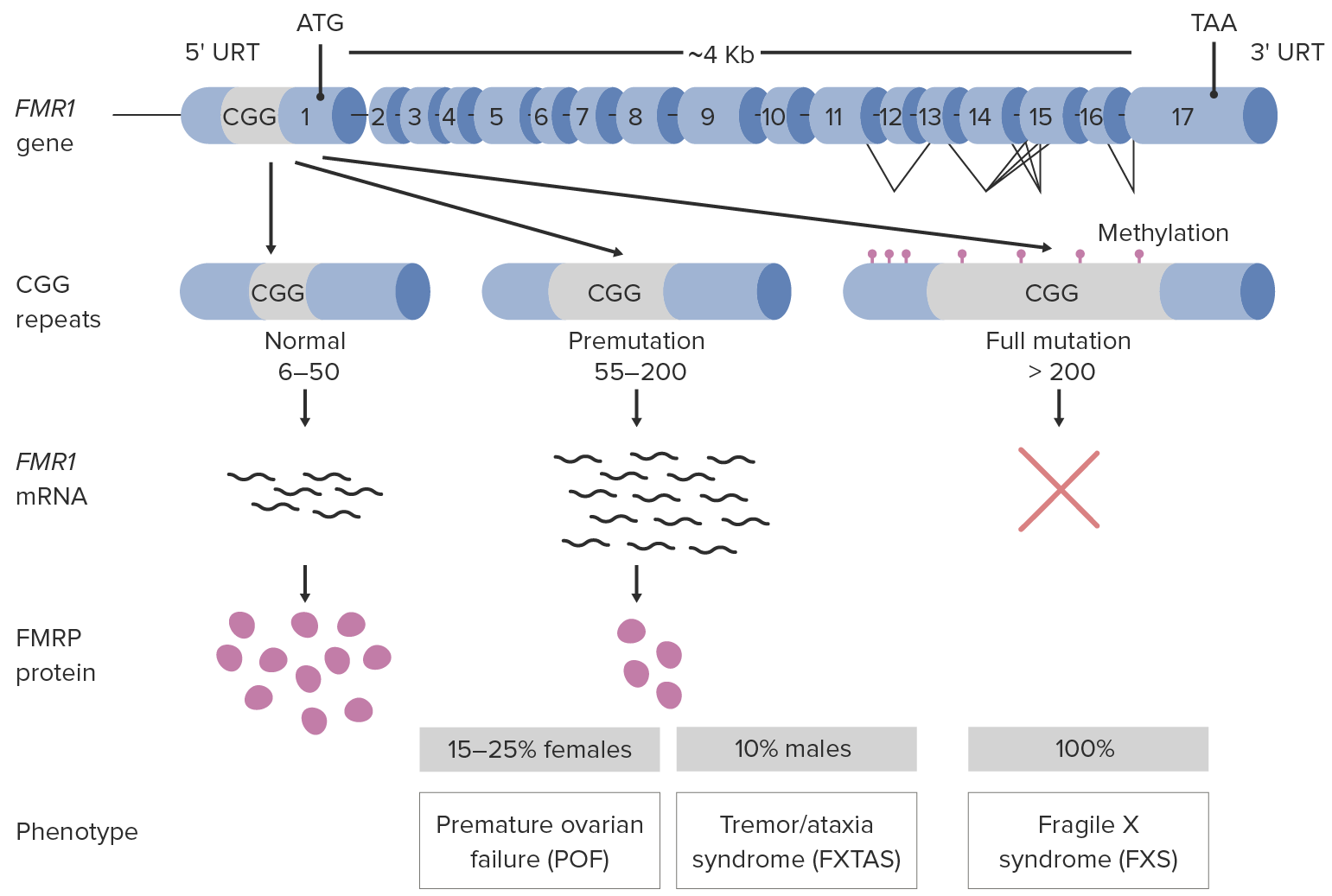Playlist
Show Playlist
Hide Playlist
Fragile X Syndrome (FXS, Martin-Bell Syndrome)
-
Slides FragileX Pediatrics.pdf
-
Download Lecture Overview
00:01 In this lecture, we're going to discuss the Fragile X Syndrome. 00:05 So Fragile X Syndrome is a trinucleotide repeat disorder. 00:10 Basically, it has a bunch of CGGs all repeating in the promoter region of FMR1 gene. 00:16 So what this does is it causes abnormal methylation and silences the FMR1 gene. 00:24 The loss of FMRP protein results and that critical in brain and testicular development. 00:31 The more repeats that there are and this happens in subsequent generations of the disease, the worse the disease gets. 00:40 So this is the most common genetic cause of intellectual disability that's inherited. 00:48 It features facial features that are long in face and these patients often have a prominent chin and prominent ears. 00:56 Also, they may develop macroorchidism and large testes and that presents typically at puberty. 01:03 Females with the disease are 1 in 4,000 to 6,000 live births. 01:09 They may have more than 200 repeats on one allele and they are much less severely affected than males. 01:16 This is because they have another x chromosome. 01:19 Females may present with mild intellectual disability and the female cells turn off one x chromosome by methylation. 01:29 So, the severity depends on how many of the fragile X side are off or how many of the good x chromosomes are off. 01:38 So, in males, the rate of the disease is 1 in 3,600 to 1 in 4,000 live births but they are much more severely affected than females and thus, we often think of this as a male disease. 01:51 If we see a patient with Fragile X, how do we diagnose it? Well, generally what we'll do is molecular testing, specifically testing that will count the CGG repeats within the target gene. 02:04 We basically analyze FMR1 gene methylation as well. 02:08 We also get ultrasound in this patient specifically an echo to rule out cardiac abnormalities and there are many different cardiac abnormalities that can arise but primarily we're talking about aortic root dilatation or may be mitrovalve prolapse. 02:23 So there's a few things we need to remember about Fragile X Syndrome. 02:28 Remember primarily, big ears, big testes, a common cause of inherited intellectual disability. 02:36 Next, it's a CGG repeat disorder in the promoter region of FMR1. 02:41 More than 200 repeats in one allele in a female makes the diagnosis. 02:47 This is the most common cause of inherited intellectual disability. 02:53 Keep in mind that subsequent generations get worse because they have more and more trinucleotide repeats. 03:00 In the first or early on in the generations of disease, there's a phenomenon known as dementia from Fragile X. 03:11 This can happen in that the patient will have a generally normal life and develop early onset dementia. 03:17 So that's a rare cause of picked-up dementia in the elderly and you'll diagnose it often by younger generations from that person who have more severe disease. 03:27 It's less severe in females significantly due to X inactivation and there is variable penetrance because it depends which x is being inactivated the most. 03:38 Also, remember the findings that are key are the long face, the large chin, the large ears and the large testes. 03:46 So that's a quick review of Fragile X Syndrome. 03:49 Thanks.
About the Lecture
The lecture Fragile X Syndrome (FXS, Martin-Bell Syndrome) by Brian Alverson, MD is from the course Pediatric Genetics.
Included Quiz Questions
Which of the following is true regarding fragile X syndrome?
- It is more severe in males.
- IQ is preserved.
- Symptoms are often evident at birth.
- It is more common in females.
- It results from a CAG trinucleotide repeat.
Which of the following is a characteristic physical finding in fragile X syndrome?
- Elongated face
- Hypoplastic earlobes
- Small-sized testes
- Muscular hypertonicity
- Rough thickened skin
Which of the following is the most common cause of inherited intellectual disability in the world?
- Fragile X syndrome
- Down syndrome
- DiGeorge syndrome
- Klinefelter syndrome
- Turner syndrome
Customer reviews
5,0 of 5 stars
| 5 Stars |
|
1 |
| 4 Stars |
|
0 |
| 3 Stars |
|
0 |
| 2 Stars |
|
0 |
| 1 Star |
|
0 |
Perfect, quick overview, ideal for the short presentation I am preparing on this disease!




